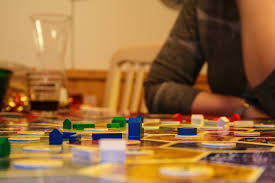Games GDD: Design Considerations
 |
| Various coloured pieces from Settlers of Catan Source: PxHere |
An interesting article that I have read this week is “Design Considerations”, by Greg Aleknevicus. In this article he discusses the factors of games that he really enjoys. These all fall under the category of physical presentation in board games. He states that he limits himself to “ideas and concerns that do not (for the most part) require extra expense beyond time”. He separates his views into categories; Components, The Box, Cards, Theme, and Rules.
- Components
The design of the components of a game can drastically increase the enjoyability and functionality of a game. Aleknevicus suggests making game tiles “smaller than the spaces they’re placed upon”. This leaves room for movement of the tiles without disturbing the other tiles around it. Making the player pieces easily distinguishable is another suggestion, albeit somewhat more difficult. Many people suffer from colour blindness, of which there are several different kinds. This makes it difficult to create pieces that are easily distinguishable to everybody, but sticking with contrasting colours is a good place to start, and using shape on top of this can ensure that the pieces cannot be easily mistaken for one another.
- The Box
While the author admits that the design of the box has no effect on the gameplay, he states that there are still issues to consider. Try as one might to reserve judgement for the game alone, first impressions are made based on the box. Placing the game’s name on the side of the box may seem obvious, but as Aleknevicus proves - it can be forgotten or overlooked. Players may use the box as a guide on how to play the game, and therefore any pictures of gameplay used on the packaging should show a legal move.
Another article that gives advice about Box Design is “8 Essential Elements for Your Custom Game Box Design”, by Mikel Andrews. He suggests giving some details about the game on the box, such as a short summary of the rules, the average play time, how many players are needed, a story set up, and some more details.
- The Cards
When using cards in these games, legibility at a glance is key. Using indices on all four corners of the cards means that the card can be read regardless of the orientation it was picked up. As well as this, using indices large enough to be read at a glance, while still being petite enough to be read with only a moderate fan of the hand. The author recommends a white border around the edges of the cards to reduce any wear and tear being immediately visible. If cards do become damaged and unusable, a good idea is to include blank cards that can be used in lieu of the destroyed card.
- Theme
Aleknevicus insists that themes should compliment the rules rather than contradict them. He uses an example of a Cave Troll being used instead of a Cave-In in the game “Fantasy Flight”. New players would often ask how to kill or move the cave troll that is blocking the way into a certain room on the board, only to be confused and disappointed when they cannot attack or uproot the troll as they can other monsters on the field. This does not make sense in the grand scheme of the rules. However, the original intent was for the Cave Troll to be a Cave-In, which would have gone along with the theme and the rules set up. Players are far less likely to want to attack a pile of rubble than a monster, and will be more accepting when they cannot do so.
- Rules
Rules are no easy task to lay out, implement and explain without at least one person misinterpreting them. The author gives some insight on some ways to minimise this possibility. Getting other people to blind test a game is a sure way to find discrepancies in the rule book. The developer and other players that already know how the game is played have a prior knowledge of the rules, and may make assumptions based on their knowledge rather than what it states in the rules. Brand new players will follow the rules laid out in the book, for better or worse. Another article on Canvas states that
“Playtesting with gamers is very different from playing with other game designers. Done right, the feedback you can get from players in your target audience is even more meaningful than getting feedback from game designers, because you are seeing firsthand how your game will be experienced by the very kinds of people who will eventually be playing the final version.”
The rules should not be vague and left open to interpretation. There should be a clear rule set to be followed, unless they make a conscious decision to change them for themselves. Including a list of components is a small detail, but can help in the case of a missing piece, and knowing exactly which piece needs replacing.
Many of the author’s points seem obvious on first thought. But in the midst of designing a game, it can be easy to get tunnel vision and lose sight on some basic features such as the game title on the side of the box. Keeping the basic fundamentals and elements in mind throughout the game development process can minimise the risk of leaving an important feature out, and increase the likelihood of a positive reception by the majority of players.
- Ultan


Comments
Post a Comment